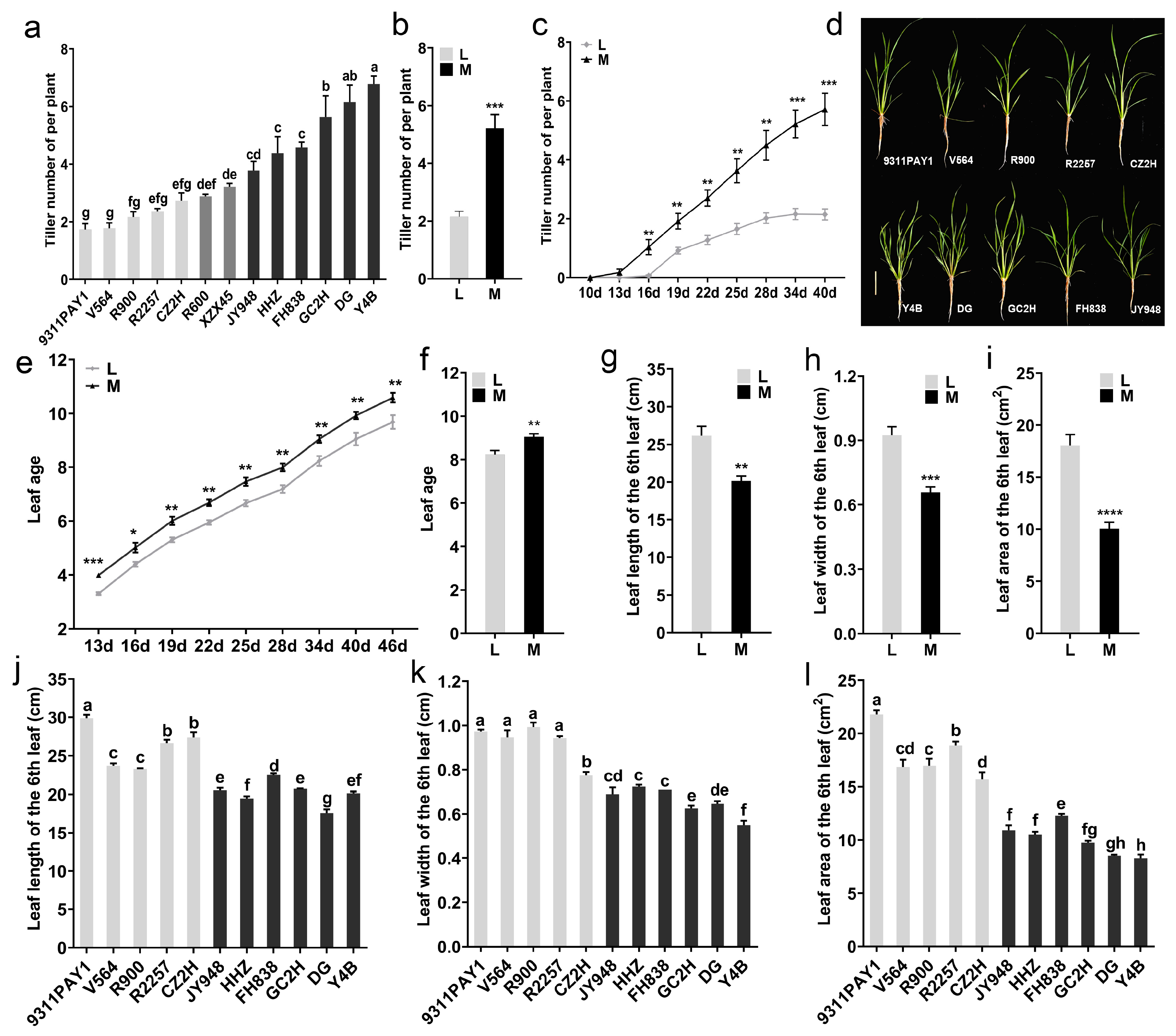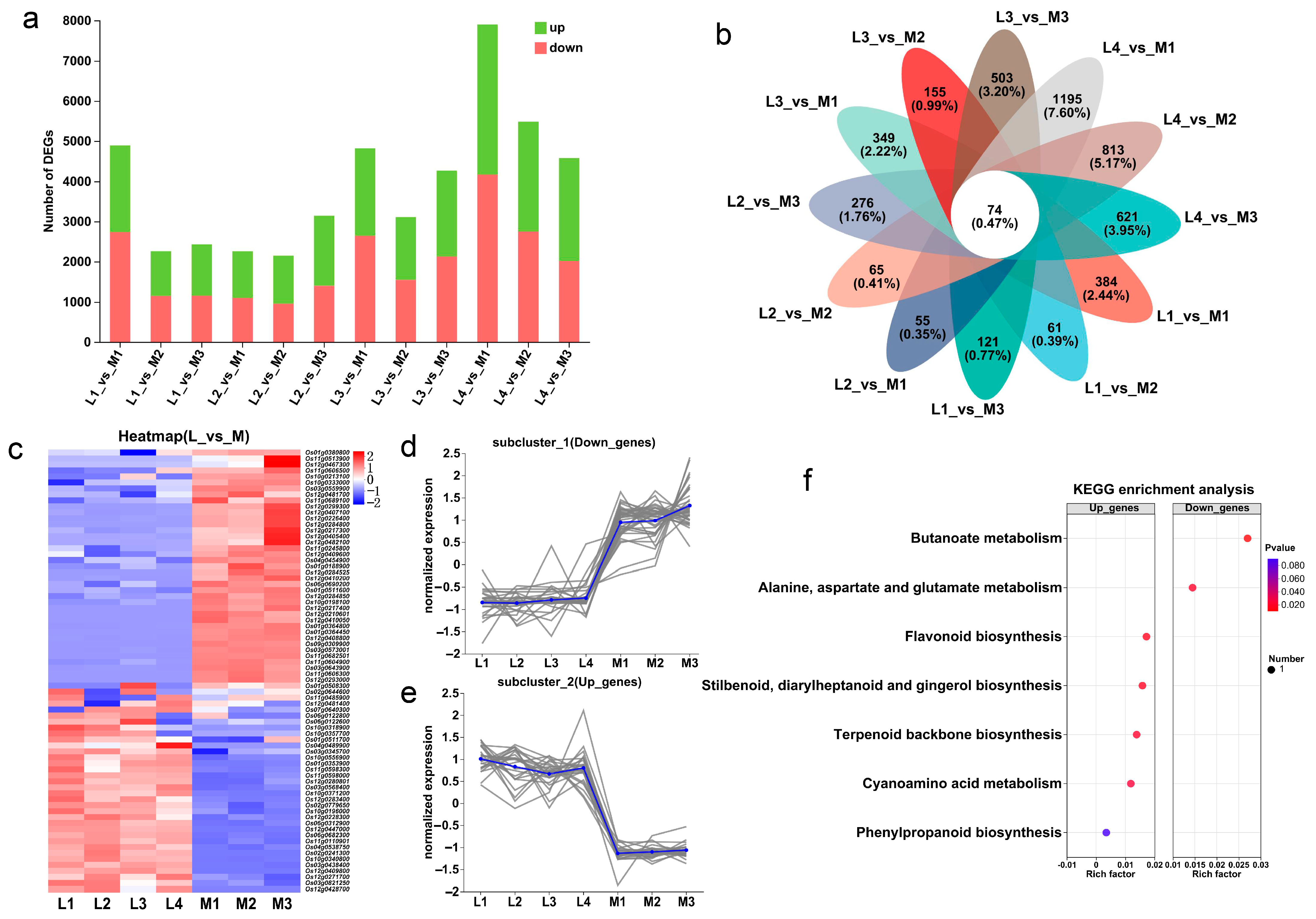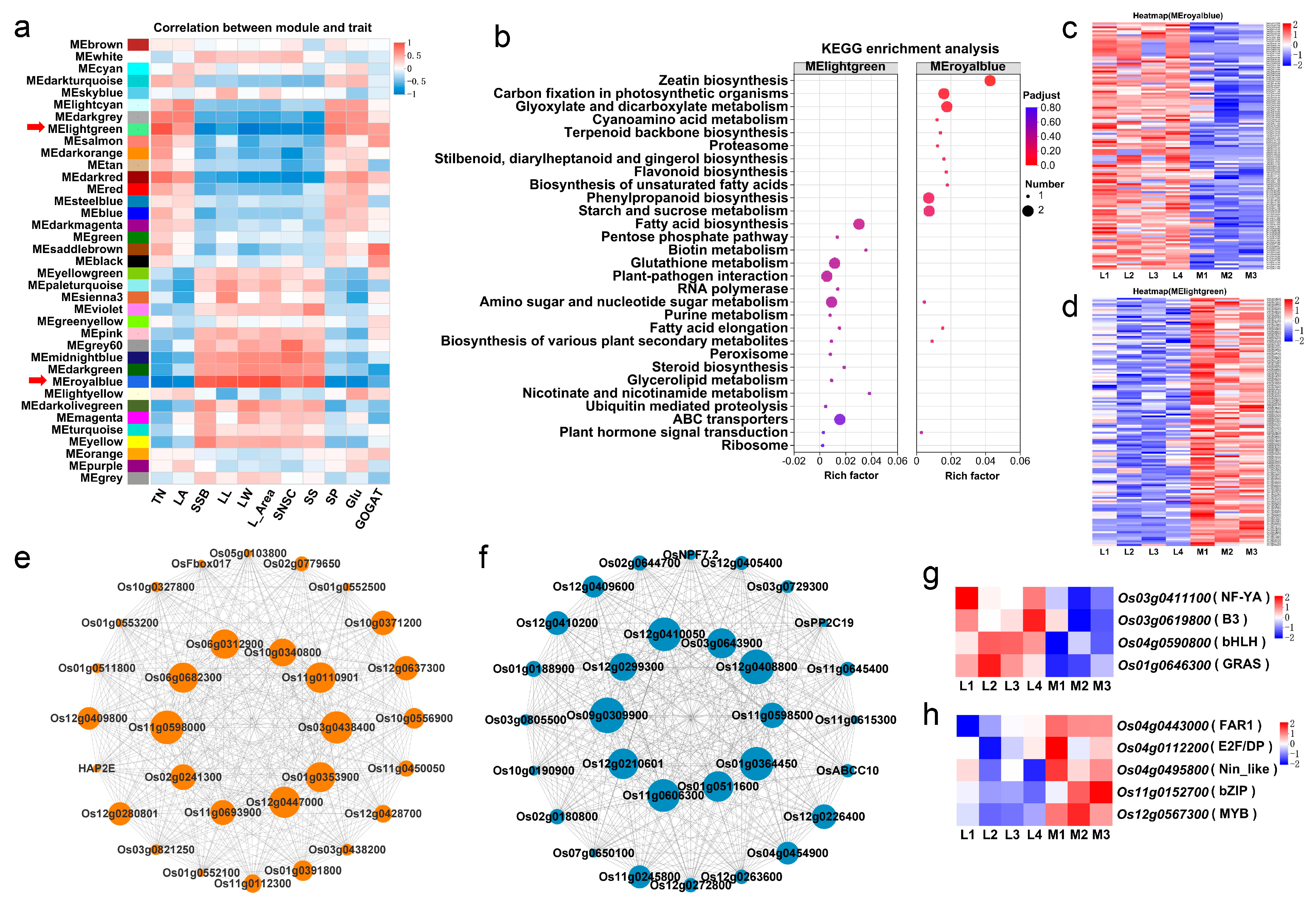Biochemical and Transcriptome Analyses Reveal a Stronger Capacity for Photosynthate Accumulation in Low-Tillering Rice Varieties
Abstract
1. Introduction
2. Results
2.1. Rice Tillering Characteristics and Related Phenotypic Traits
2.2. The Accumulation and Distribution of Dry Matter in Rice Seedlings
2.3. Carbon and Nitrogen Metabolites and Enzyme Activities of the Rice Seedlings
2.4. Identification and Functional Enrichment Analysis of Core Conserved DEGs of Rice Seedlings at the Tillering Stage
2.5. The Identification of DEGs Associated with Rice Tillering Regulation by WGCNA
3. Discussion
4. Materials and Methods
4.1. Plant Materials and Growing Conditions
4.2. Field Traits Examination
4.3. Measurement of Above-Ground Dry Matter
4.4. Measurement of Physiological and Biochemical Indicators Related to Carbon and Nitrogen Metabolism
4.5. RNA-Seq Assembly and Analysis
4.6. qRT-PCR Analysis and Validation
4.7. Weighted Gene Co-Expression Network Analysis for the Construction of Modules
4.8. Statistical Analysis
Supplementary Materials
Author Contributions
Funding
Institutional Review Board Statement
Informed Consent Statement
Data Availability Statement
Conflicts of Interest
References
- Abbas, A.; Murtaza, S.; Aslam, F.; Khawar, A.; Rafique, S.; Naheed, S. Effect of processing on nutritional value of rice (Oryza sativa). World J. Med. Sci. 2011, 6, 68–73. [Google Scholar]
- Fageria, N. Yield physiology of rice. J. Plant Nutr. 2007, 30, 843–879. [Google Scholar] [CrossRef]
- Xing, Y.; Zhang, Q. Genetic and molecular bases of rice yield. Annu. Rev. Plant Biol. 2010, 61, 421–442. [Google Scholar] [CrossRef]
- Zhong, X.; Hussain, H.A.; Zhao, B.; Huang, M.; Hussain, S.; Xie, R.; Cai, L.; Yun, H.; He, G.; Zhang, C. Analysis of grain yield formation components of extra heavy-panicle-type mid-season Indica hybrid rice. J. Plant Growth Regul. 2022, 41, 936–953. [Google Scholar] [CrossRef]
- Wang, Y.; Shang, L.; Yu, H.; Zeng, L.; Hu, J.; Ni, S.; Rao, Y.; Li, S.; Chu, J.; Meng, X. A strigolactone biosynthesis gene contributed to the green revolution in rice. Mol. Plant 2020, 13, 923–932. [Google Scholar] [CrossRef]
- Jiang, Y.; Zhang, H.; Zhao, K.; Xu, J.; Wei, H.; Long, H.; Wang, W.; Huo, Z.; Xu, K.; Wei, H. Difference in yield and its components characteristics of different type rice cultivars in the lower reaches of the Yangtze river. Chin. J. Rice Sci. 2014, 28, 621–631. [Google Scholar]
- Pasuquin, E.; Lafarge, T.; Tubana, B. Transplanting young seedlings in irrigated rice fields: Early and high tiller production enhanced grain yield. Field Crops Res. 2008, 105, 141–155. [Google Scholar] [CrossRef]
- Lin, J.; Li, G.; Xue, L.; Zhang, W.; Xu, H.; Wang, S.; Yang, L.; Ding, Y. Subdivision of nitrogen use efficiency of rice based on N tracer. Acta Agron. Sin. 2014, 40, 1424–1434. [Google Scholar] [CrossRef]
- Pengyan, J.; Xiaofu, H.; Laiding, F. The effect of nitrogen concentration on nitrogen absorption and tiller development in rice under water culture. Acta Agron. Sin. China 1997, 23, 191–199. [Google Scholar]
- Khush, G.S. Breaking the yield frontier of rice. GeoJournal 1995, 35, 329–332. [Google Scholar] [CrossRef]
- Yang, Z.; Li, N.; Ma, J.; Sun, Y.; Xu, H. High-yielding traits of heavy panicle varieties under triangle planting geometry: A new plant spatial configuration for hybrid rice in China. Field Crops Res. 2014, 168, 135–147. [Google Scholar] [CrossRef]
- Qing, T.; Lian, H.; Shuang, L.; LI, W.; Fei, D.; Wei, Z.; Xiao, Z.; Wan, R. Indica rice restorer lines with large sink potential exhibit improved nutrient transportation to the panicle, which enhances both yield and nitrogen-use efficiency. J. Integr. Agric. 2021, 20, 1438–1456. [Google Scholar]
- Huang, L.; Yang, D.; Li, X.; Peng, S.; Wang, F. Coordination of high grain yield and high nitrogen use efficiency through large sink size and high post-heading source capacity in rice. Field Crops Res. 2019, 233, 49–58. [Google Scholar] [CrossRef]
- Commichau, F.M.; Forchhammer, K.; Stülke, J. Regulatory links between carbon and nitrogen metabolism. Curr. Opin. Microbiol. 2006, 9, 167–172. [Google Scholar] [CrossRef]
- Nunes-Nesi, A.; Fernie, A.R.; Stitt, M. Metabolic and signaling aspects underpinning the regulation of plant carbon nitrogen interactions. Mol. Plant 2010, 3, 973–996. [Google Scholar] [CrossRef]
- Xin, Z.; Long, S.P.; Ort, D.R. What is the maximum efficiency with which photosynthesis can convert solar energy into biomass? Curr. Opin. Biotechnol. 2008, 19, 153–159. [Google Scholar]
- Foyer, C.H.; Noctor, G.; Verrier, P. Photosynthetic carbon-nitrogen interactions: Modelling inter-pathway control and signalling. In Annual Plant Reviews Volume 22: Control of Primary Metabolism in Plants; Blackwell Publishing Ltd.: Oxford, UK, 2006; pp. 325–347. [Google Scholar]
- Wei, L.; Fei, S.; Qun, L.; Chen, L.; Jing, Z. Tillering and panicle branching genes in rice. Gene 2014, 537, 1–5. [Google Scholar]
- Ye, J.Y.; Tian, W.H.; Jin, C.W. Nitrogen in plants: From nutrition to the modulation of abiotic stress adaptation. Stress Biol. 2022, 2, 4. [Google Scholar] [CrossRef] [PubMed]
- Miyako, K.; Atsushi, F.; Henning, R.; Kazuki, S. Metabolomic approaches toward understanding nitrogen metabolism in plants. J. Exp. Bot. 2011, 62, 1439–1453. [Google Scholar]
- Kuypers, M.M.; Marchant, H.K.; Kartal, B. The microbial nitrogen-cycling network. Nat. Rev. Microbiol. 2018, 16, 263–276. [Google Scholar] [CrossRef] [PubMed]
- Tanaka, A.; Garcia, C.V. Studies of the relationship between tillering and nitrogen uptake of the rice plant: 2. Relation between tillering and nitrogen metabolism of the plant. Soil Sci. Plant Nutr. 1965, 11, 31–37. [Google Scholar] [CrossRef]
- Shou, P.; Le, L.; Xiaohong, L.; Hongxuan, W.; Guohua, X.U. Effects of nitrogen on rice tiller bud development and its mechanism. J. Nanjing Agric. Univ. 2016, 39, 973–978. [Google Scholar]
- Yang, L.; Qiang, W.; Yan, D.; Qiang, W.; De, M.; Shao, W. Effect of nitrogen and 6-BA on development of tillering bud and its physiological mechanism. Acta Agron. Sin. 2009, 35, 1893–1899. [Google Scholar]
- Wen, T.; Qi, A.; Gang, H.; Shao, L.; Hai, C.; Zhi, Z. The relationship between early tillers at low-nodes and leaf morphological characters,carbon and nitrogen metabolism in rice. Hubei Agric. Sci. 2019, 58, 22–29. [Google Scholar]
- Brugnoli, E.; Scartazza, A.; Lauteri, M.; Monteverdi, M.C.; Máguas, C. Carbon isotope discrimination in structural and non-structural carbohydrates in relation to productivity and adaptation to unfavourable conditions. In Garland Science; BIOS Scientific Publishers: Oxford, UK, 2020; pp. 133–146. [Google Scholar]
- Frank, A.B.; Bauer, A.; Black, A.L. Carbohydrate, nitrogen, and phosphorus concentrations of spring wheat leaves and stems. Agron. J. 1989, 81, 524–528. [Google Scholar] [CrossRef]
- Wen, Y.; Hui, H. Effects of uniconazole waterless-dressing seed on endogenous hormones and C/N ratio at tillering stage of wheat. Acta Agron. Sin. 2005, 31, 760–765. [Google Scholar]
- Smeekens, S.; Jing, M.; Hanson, J.; Rolland, F. Sugar signals and molecular networks controlling plant growth. Curr. Opin. Plant Biol. 2010, 13, 273–278. [Google Scholar] [CrossRef] [PubMed]
- Mason, M.G.; Ross, J.J.; Babst, B.A.; Wienclaw, B.N.; Beveridge, C.A. Sugar demand, not auxin, is the initial regulator of apical dominance. Proc. Natl. Acad. Ences 2014, 111, 6092–6097. [Google Scholar] [CrossRef] [PubMed]
- Pan, Q.M.; Han, X.G.; Bai, Y.F.; Yang, J.C. Advances in physiology and ecology studies on stored non-structure carbohydrates in Plants. Chin. Bull. Bot. 2002, 19, 30–38. [Google Scholar]
- Scofield, G.N.; Ruuska, S.A.; Aoki, N.; Lewis, D.C.; Tabe, L.M.; Jenkins, C.L. Starch storage in the stems of wheat plants: Localization and temporal changes. Ann. Bot. 2009, 103, 859–868. [Google Scholar] [CrossRef] [PubMed]
- Katagiri, F.; Chua, N.H. Plant transcription factors: Present knowledge and future challenges. Trends Genet. 1992, 8, 22–27. [Google Scholar] [CrossRef]
- Liu, L.; White, M.J.; Macrae, T.H. Transcription factors and their genes in higher plants functional domains, evolution and regulation. Febs J. 1999, 262, 247–257. [Google Scholar]
- Wei, H.; Ling, Q.; Zhang, H.; Guo, W.; Yang, J.; Chen, D.; Leng, S.; Lu, W.; Xing, Z. The quality of crop population and its key regulation technology. J. Yangzhou Univ. Agric. Life Sci. Ed. 2018, 39, 1–9. [Google Scholar]
- He, W.; Jun, M.; He, W.; Lin, Y.; Ren, W.; Ping, T.; Tai, F.; Min, L. Growth and developmental characteristics and yield formation of super hybrid rice. Hybrid Rice 2007, 22, 57–62. [Google Scholar]
- Jiang, P.; Hong, X.; Fen, L.; Ma, Y.; Xu, Z.; Ni, Z.; Liu, Z. Transportation and distribution of assimilation product in rice plant individuals by using 14C-glucose. Acta Agric. Zhejianensis 1994, 6, 65–70. [Google Scholar]
- Nuruzzaman, M.; Yamamoto, Y.; Nitta, Y.; Yoshida, T.; Miyazaki, A. Varietal differences in tillering ability of fourteen japonica and indica rice varieties. Soil Sci. Plant Nutr. 2000, 46, 381–391. [Google Scholar]
- Zufang, S.; Juan, Z.; Huibin, W.; Yonglin, D.; Yajie, Z. Study on relationship of tiller development of rice population with the effective ear percentage and rice formulation. J. Jiangsu Agric. Coll. 1997, 18, 36–40. [Google Scholar]
- Khush, G.S. Green revolution: The way forward. Nat. Rev. Genet. 2001, 2, 815–822. [Google Scholar] [CrossRef] [PubMed]
- Ordonio, R.L.; Matsuoka, M. New path towards a better rice architecture. Cell Res. 2017, 27, 1189–1190. [Google Scholar] [CrossRef] [PubMed]
- González-Navarro, O.E.; Griffiths, S.; Molero, G.; Reynolds, M.P.; Slafer, G.A. Dynamics of floret development determining differences in spike fertility in an elite population of wheat. Field Crops Res. 2015, 172, 21–31. [Google Scholar] [CrossRef]
- Su, Z.; Li, Y.; Guo, H.; Zhang, H.; Li, G. Discussion on the relationship between the culm-sheath weight per shoot and yield in rice and its cultural approaches of high yield. J. Jiangsu Agric. Coll. 1993, 14, 1–10. [Google Scholar]
- Zhang, Y.; Zhu, D.; Cao, W.; Lin, X.; Chen, H.; Jiao, G. Panicle parameters and their relationships of rice varieties with different type of panicle. J. Yunnan Agric. Univ. 2010, 25, 327–332. [Google Scholar]
- Hu, Y.; Liu, J.; Lin, Y.; Xu, X.; Xia, Y.; Bai, J.; Yu, Y.; Xiao, F.; Ding, Y.; Ding, C. Sucrose nonfermenting-1-related protein kinase 1 regulates sheath-to-panicle transport of nonstructural carbohydrates during rice grain filling. Plant Physiol. 2022, 189, 1694–1714. [Google Scholar] [CrossRef]
- Yoshiji, T.; Kanoe, S. Studies on the production and behavior of carbohydrates in rice plant: II. On the accumulation and distribution of starches in the organs of rice plant with its development of growth. Jpn. J. Crop Sci. 2008, 22, 98–99. [Google Scholar]
- Slewinski, T.L. Non-structural carbohydrate partitioning in grass stems: A target to increase yield stability, stress tolerance, and biofuel production. J. Exp. Bot. 2012, 63, 4647–4670. [Google Scholar] [CrossRef] [PubMed]
- Chan, Z.; Bao, J.; Shu, W.; Yuan, H.; Wen, W. Effects of nitrogen fertilizer applications on photosynthetic production and yield of japonica rice. Int. J. Plant Prod. 2021, 15, 599–613. [Google Scholar]
- Nai, D.; Hong, L. Contribution of phenylpropanoid metabolism to plant development and plant–environment interactions. J. Integr. Plant Biol. 2021, 63, 180–209. [Google Scholar]
- Saffer, A.M.; Irish, V.F. Flavonol rhamnosylation indirectly modifies the cell wall defects of RHAMNOSE BIOSYNTHESIS1 mutants by altering rhamnose flux. Plant J. 2018, 94, 649–660. [Google Scholar] [CrossRef] [PubMed]
- Tan, X.; Zhang, H.; Yang, Z.; Wei, Z.; Li, Y.; Chen, J.; Sun, Z. NF-YA transcription factors suppress jasmonic acid-mediated antiviral defense and facilitate viral infection in rice. PLoS Pathog. 2022, 18, e1010548. [Google Scholar] [CrossRef] [PubMed]
- Itoh, H.; Shimada, A.; Ueguchi-Tanaka, M.; Kamiya, N.; Hasegawa, Y.; Ashikari, M.; Matsuoka, M. Overexpression of a GRAS protein lacking the DELLA domain confers altered gibberellin responses in rice. Plant J. Cell Mol. Biol. 2005, 444, 669–679. [Google Scholar] [CrossRef] [PubMed]
- Wang, Y.; Chen, K.; Yao, Q. Progress of studies on bHLH transcription factor families. Hereditas 2008, 30, 821–830. [Google Scholar] [CrossRef]
- Ying, L.; Zhi, D. The function and structure of plant B3 domain transcription factor. Mol. Plant Breed. 2017, 15, 1868–1873. [Google Scholar]
- Yi, Y.; Peng, Y.; Song, T.; Lu, S.; Teng, Z.; Zheng, Q.; Zhao, F.; Meng, S.; Liu, B.; Peng, Y.; et al. NLP2-NR module associated NO is involved in regulating seed germination in rice under salt stress. Plants 2022, 11, 795. [Google Scholar] [CrossRef]
- Perrotta, L.; Giordo, R.; Francis, D.; Rogers, H.J.; Albani, D. Molecular analysis of the E2F/DP gene family of daucus carota and involvement of the DcE2F1 factor in cell proliferation. Front. Plant Sci. 2021, 12, 652570. [Google Scholar] [CrossRef]
- Cai, Y.; Liu, Y.; Fan, Y.; Li, X.; Yang, M.; Xu, D.; Wang, H.; Deng, X.W.; Li, J. MYB112 connects light and circadian clock signals to promote hypocotyl elongation in Arabidopsis. Plant Cell 2023, 35, 3485–3503. [Google Scholar] [CrossRef] [PubMed]
- Liu, Z.; An, C.; Zhao, Y.; Xiao, Y.; Gao, Y. Genome-wide identification and characterization of the CsFHY3/FAR1 gene family and expression analysis under biotic and abiotic stresses in tea plants (Camellia sinensis). Plants 2021, 10, 570. [Google Scholar] [CrossRef] [PubMed]
- Nijhawan, A.; Jain, M.; Tyagi, A.K.; Khurana, J.P. Genomic survey and gene expression analysis of the basic leucine zipper transcription factor family in rice. Plant Physiol. 2008, 146, 333–350. [Google Scholar] [CrossRef]
- Palaniswamy, K.M.; Gomez, K.A. Length-width method for estimating leaf area of rice. Agron. J. 1974, 66, 430–433. [Google Scholar] [CrossRef]
- Li, G.; Hu, Q.; Shi, Y.; Cui, K.; Nie, L.; Huang, J.; Peng, S. Low nitrogen application enhances starch-metabolizing enzyme activity and improves accumulation and translocation of non-structural carbohydrates in rice stems. Front. Plant Sci. 2018, 9, 1128. [Google Scholar] [CrossRef]
- Shi, H.; Wang, B.; Yang, P.; Li, Y.; Miao, F. Differences in sugar accumulation and mobilization between sequential and non-sequential senescence wheat cultivars under natural and drought conditions. PLoS ONE 2016, 11, e0166155. [Google Scholar] [CrossRef] [PubMed]
- Li, H.; Liang, Z.; Ding, G.; Shi, L.; Xu, F.; Cai, H. A natural light/dark cycle regulation of carbon-nitrogen metabolism and gene expression in rice shoots. Front. Plant Sci. 2016, 7, 1318. [Google Scholar] [CrossRef]
- Bradford, M.M. A rapid and sensitive method for the quantitation of microgram quantities of protein utilizing the principle of protein-dye binding. Anal. Biochem. 1976, 72, 248–254. [Google Scholar] [CrossRef]
- Shih, S.; Yi, L.; Yih, W.; Min, C. Efficiency improvements on ninhydrin method for amino acid quantification. J. Food Compos. Anal. 2006, 19, 112–117. [Google Scholar]
- Sánchez, E.; Rivero, R.M.; Ruiz, J.M.; Romero, L. Changes in biomass, enzymatic activity and protein concentration in roots and leaves of green bean plants (Phaseolus vulgaris L. cv. Strike) under high NH4NO3 application rates. Sci. Hortic. 2004, 99, 237–248. [Google Scholar] [CrossRef]
- Somnath, K.; Chu, K.L.; Gill, S.S.; Allen, D.K. An efficient LC-MS method for isomer separation and detection of sugars, phosphorylated sugars, and organic acids. J. Exp. Bot. 2022, 73, 2938–2952. [Google Scholar]
- Kim, D.; Langmead, B.; Salzberg, S.L. HISAT: A fast spliced aligner with low memory requirements. Nat. Methods 2015, 12, 357–360. [Google Scholar] [CrossRef] [PubMed]
- Pertea, M.; Pertea, G.M.; Antonescu, C.M.; Chang, T.C.; Mendell, J.T.; Salzberg, S.L. StringTie enables improved reconstruction of a transcriptome from RNA-seq reads. Nat. Biotechnol. 2015, 33, 290–295. [Google Scholar] [CrossRef]
- Mortazavi, A.; Williams, B.A.; McCue, K.; Schaeffer, L.; Wold, B. Mapping and quantifying mammalian transcriptomes by RNA-Seq. Nat. Methods 2008, 5, 621–628. [Google Scholar] [CrossRef] [PubMed]
- Livak, K.J.; Schmittgen, T.D. Analysis of relative gene expression data using real-time quantitative PCR and the 2−ΔΔCT method. Methods 2001, 25, 402–408. [Google Scholar] [CrossRef] [PubMed]
- Langfelder, P.; Horvath, S. WGCNA: An R package for weighted correlation network analysis. BMC Bioinform. 2008, 9, 559. [Google Scholar] [CrossRef]
- Huynh, N.P.; Zhang, B.; Guilak, F. High-depth transcriptomic profiling reveals the temporal gene signature of human mesenchymal stem cells during chondrogenesis. FASEB J. 2019, 33, 358–372. [Google Scholar] [CrossRef] [PubMed]
- Fatima, A.; Connaughton, R.M.; Weiser, A.; Murphy, A.M.; O’Grada, C.; Ryan, M.; Brennan, L.; O’Gaora, P.; Roche, H.M. Weighted gene co-expression network analysis identifies gender specific modules and hub genes related to metabolism and inflammation in response to an acute lipid challenge. Mol. Nutr. Food Res. 2018, 62, 1700388. [Google Scholar] [CrossRef] [PubMed]





Disclaimer/Publisher’s Note: The statements, opinions and data contained in all publications are solely those of the individual author(s) and contributor(s) and not of MDPI and/or the editor(s). MDPI and/or the editor(s) disclaim responsibility for any injury to people or property resulting from any ideas, methods, instructions or products referred to in the content. |
© 2024 by the authors. Licensee MDPI, Basel, Switzerland. This article is an open access article distributed under the terms and conditions of the Creative Commons Attribution (CC BY) license (https://creativecommons.org/licenses/by/4.0/).
Share and Cite
Zhu, M.; Jiang, S.; Huang, J.; Li, Z.; Xu, S.; Liu, S.; He, Y.; Zhang, Z. Biochemical and Transcriptome Analyses Reveal a Stronger Capacity for Photosynthate Accumulation in Low-Tillering Rice Varieties. Int. J. Mol. Sci. 2024, 25, 1648. https://doi.org/10.3390/ijms25031648
Zhu M, Jiang S, Huang J, Li Z, Xu S, Liu S, He Y, Zhang Z. Biochemical and Transcriptome Analyses Reveal a Stronger Capacity for Photosynthate Accumulation in Low-Tillering Rice Varieties. International Journal of Molecular Sciences. 2024; 25(3):1648. https://doi.org/10.3390/ijms25031648
Chicago/Turabian StyleZhu, Mingqiang, Shan Jiang, Jinqiu Huang, Zhihui Li, Shuang Xu, Shaojia Liu, Yonggang He, and Zhihong Zhang. 2024. "Biochemical and Transcriptome Analyses Reveal a Stronger Capacity for Photosynthate Accumulation in Low-Tillering Rice Varieties" International Journal of Molecular Sciences 25, no. 3: 1648. https://doi.org/10.3390/ijms25031648
APA StyleZhu, M., Jiang, S., Huang, J., Li, Z., Xu, S., Liu, S., He, Y., & Zhang, Z. (2024). Biochemical and Transcriptome Analyses Reveal a Stronger Capacity for Photosynthate Accumulation in Low-Tillering Rice Varieties. International Journal of Molecular Sciences, 25(3), 1648. https://doi.org/10.3390/ijms25031648





